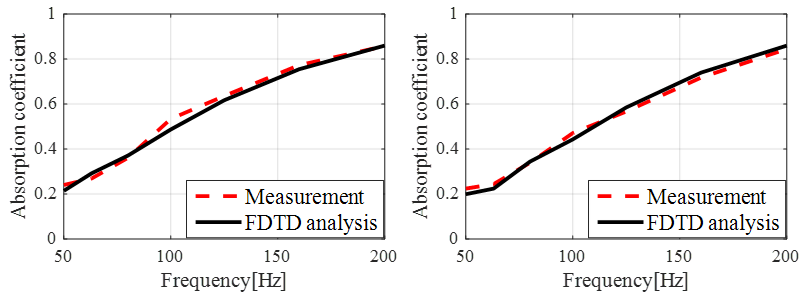The anechoic chamber is a special laboratory for acoustic testing,in which a free sound field in a closed space is established. 1The cut-off frequency is defined as the frequency at which the sound absorption coefficient is 0.99 under the normal incident.
With the development of numerical methods, it is possible to design a proper acoustic wedge by using finite element method, boundary element method or COMSOL software. However, no numerical method based on the finite-difference time-domain (FDTD) algorithm has been raised. Recently, researchers from the Institute of Acoustics of the Chinese Academy of Sciences (IACAS) proposed a method for predicting the sound absorption coefficient of acoustic wedges by using the FDTD algorithm.
The related research results were recently published in Applied Acoustics.
The acoustic wedge is generally composed of rigid-frame porous material. The wave equations in the rigid-frame porous material can be described by the equivalent fluid model. Researchers designed the equivalent bulk modulus and the equivalent density in the frequency-domain wave equations as the infinite impulse filter. By applying the Z-transform theory, the frequency-domain wave equations were firstly changed to Z domain, and then transformed to time domain. Thus, the equivalent fluid model based finite-difference time-domain algorithm (EF-FDTD algorithm) was obtained.
By using the EF-FDTD algorithm, the absorption coefficient of the porous material under the normal incidence, the oblique incidence and the absorption coefficient of acoustic wedges could be predicted.
For two types of acoustic wedges, the measured and predicted absorption coefficients were plotted in the figure. Obviously, the predicted absorption coefficients were very close to the measured values.
The EF-FDTD algorithm could accurately simulate the sound field containing the porous materials, and predict sound absorption coefficients of different acoustic wedges.
The research was supported by National Key R&D Program of China (NO. 2017YFC082240203) and the National Natural Science Foundation of China [grant number 11774379].

Figure 1. The measured and predicted absorption coefficients for two types of acoustic wedges. (Image by IOA)
Reference:
ZHAO Jing, CHEN Zhifei, BAO Ming, Shinichi Sakamoto. Prediction of sound absorption coefficients of acoustic wedges using finite-difference time-domain analysis. Applied Acoustics, 2019. DOI: 10.1016/j.apacoust.2019.06.002.
Contact:
ZHOU Wenjia
Institute of Acoustics, Chinese Academy of Sciences, 100190 Beijing, China
E-mail: media@mail.ioa.ac.cn


